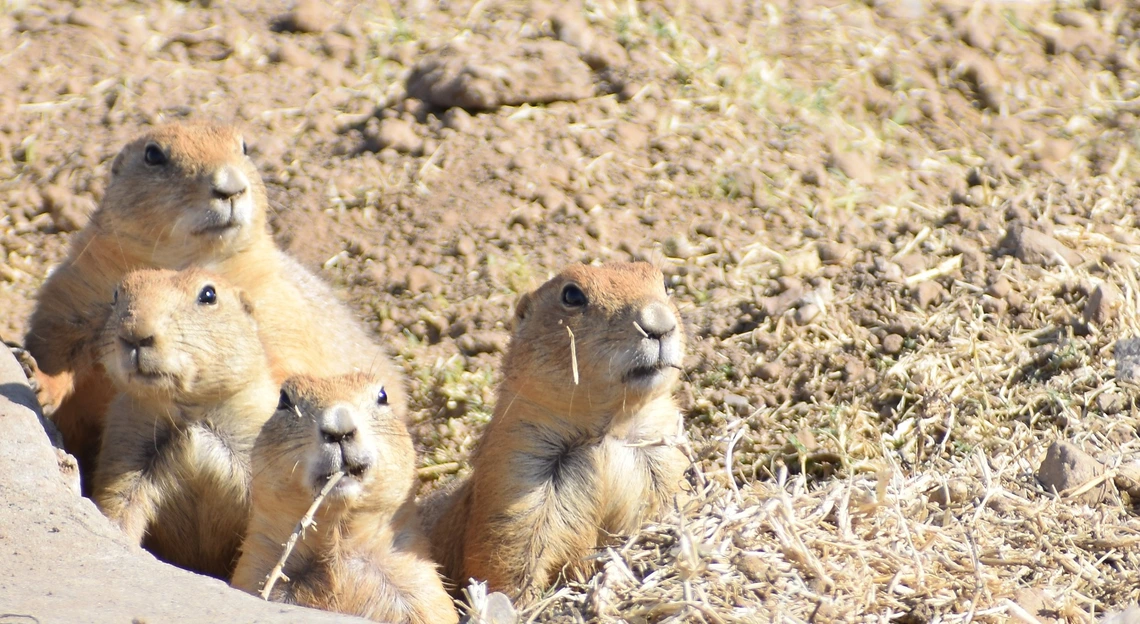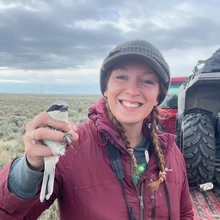What can prairie dogs teach us about wildfire management?

Black-tailed prairie dogs eat vegetation, create burrows and clear ground. Do those habits impact the spread of wildfires? Researchers from the University of Arizona are calling for more investigations into the small mammal's role in fire management and mitigation strategies.
Courtney Duchardt/College of Agriculture, Life and Environmental Sciences
In the battle to manage wildfires, experts often turn to advanced technologies and evolving techniques for help, but could the next breakthrough in fire management be found right under their feet?
If those experts are standing in the Great Plains, then the answer might be yes, said Courtney Duchardt, assistant professor in the University of Arizona College of Agriculture, Life and Environmental Sciences.

Courtney Duchardt
Duchardt is the lead author of a new paper published in the journal BioScience arguing that historical fire patterns, current fire management strategies and unpublished data strongly suggest that black-tailed prairie dogs are likely to reduce wildfire spread and intensity.
"Black-tailed prairie dogs are eating vegetation, creating burrows and bare ground," Duchardt said. "But they are not only eating vegetation. They are actively clipping it and keeping it short so that they can see predators, and their long-term occupancy leads to a shift in the types of vegetation that grows. You see a kind of shift from more grass to smaller, flowering plants and a lot barer ground that can act as a kind of fire stop."
Duchardt discovered the impact prairie dogs have on their environment while researching fire, grazing and bird behavior across the Great Plains. Over time, she noticed a consistent factor across many of her sites: the presence of prairie dog colonies that appeared to alter the landscape in ways that made fire behave differently.
Intrigued, she and other researchers asked a simple question: Do prairie dog colonies actually affect wildfire behavior? When Duchardt and her colleagues began a review of previous research, only one of the 34 studies they found directly examined the effect of prairie dogs on wildfire.

Trail camera footage shows a wildfire burning across the Great Plains but stopping short of a prairie dog colony, leaving the area around the burrows unburned.
Courtney Duchardt/College of Agriculture, Life and Environmental Sciences
This newly observed connection between prairie dogs and wildfire places the small mammals in a larger discussion of something called "disturbance regimes," Duchardt said.
Disturbance regimes are events like fires and floods that have shaped the Great Plains for millennia. It also includes more recent human activities like logging, mining and agriculture that have further transformed ecosystems. These disturbance regimes can sometimes degrade the environment, but in many cases, they play a vital role in maintaining ecosystem health.
"While there are real conflicts when it comes to prairie dog management, this species and a lot of other wildlife species may be providing ecosystem services that we really haven't quantified yet," Duchardt said. "We want to really think about the potential ecosystem services of these species, because we might lose them and then run into problems that we didn't think about ahead of time."
Black-tailed prairie dogs are also native to southeastern Arizona, Duchardt added, and have been shown to help control mesquite growth – likely contributing to historical wildfire mitigation.
Duchardt collaborated with Jacob Hennig, assistant professor in the School of Natural Resources and the Environment, along with researchers from the U.S. Department of Agriculture, the Smithsonian's Migratory Bird Center, Oklahoma State University, the University of Wyoming, Northern Illinois University and the City of Boulder. The group is calling for more research and an integrated approach to fire management. By incorporating prairie dog activity into fire behavior models, land managers could develop more effective strategies for fire prevention and mitigation, particularly in vulnerable grassland ecosystems.





